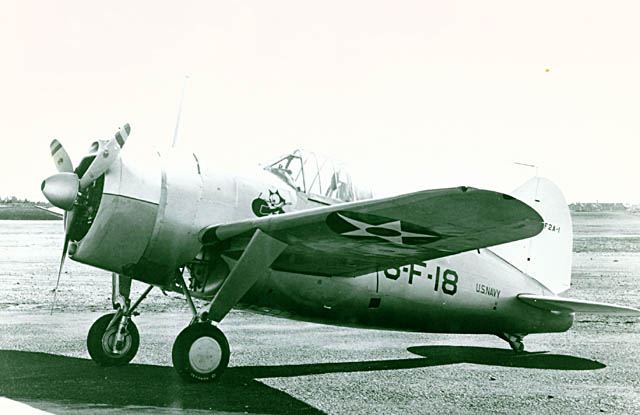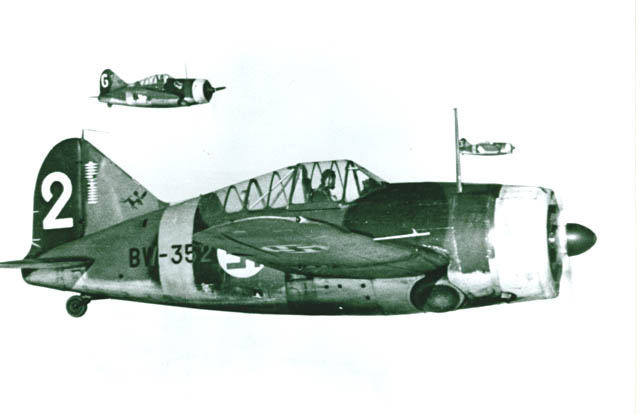|
Brewster F2A-1 & Model 239
by Jim Maas
|
 |
|
Brewster F2A-1 |

HyperScale is proudly supported by Squadron
Brewster
F2A-1 and Model 239 |
By the mid-1930s, the U.S. Navy needed to replace its biplane
fighters with a more modern aircraft. After a competition among several
manufacturers, the entry from the fledgling Brewster Aeronautical Corp. of
Queens, New York, was chosen.
Designed by Dayton Brown, the F2A-1 was an all-metal monoplane with retractable
landing gear and (for the time) exceptional pilot visibility
Following an order for 54 aircraft, the Brewster F2A-1 began to enter squadron
service with the U.S. Navy in the fall of 1939.
F2A-1s equipped Fighting Three (VF-3) alongside Grumman F2F’s. However, the
Brewster Aeronautical Corp. was already demonstrating the more powerful XF2A-2,
which the Navy would have preferred. Deliveries to the Navy were halted after
the first eleven; only VF-3 was partially equipped, operating its F2A-1s
alongside older Grumman F3F biplanes.
At the same time, the Soviet Union attacked Finland when the Finns refused
Soviet demands for territorial concessions. Finland desperately sought modern
armaments including aircraft from abroad. Despite the isolationist sentiment of
the time, there was strong American sympathy for the Finns’ David-and-Goliath
struggle. Finnish representatives, the U.S. State Department and the Navy worked
out a deal by which the Navy would relinquish most of its F2A-1 contract (43
aircraft) in favor of Finland, to be replaced by an equal number of F2A-2
fighters later. Brewster would ‘denavalize’ these aircraft as the initial part
of a Finnish order for 66, under the export designation of Model 239. The life
raft container and tailhook were deleted, and a different style RDF loop
substituted. Once in Finnish service, Revi-type reflector gunsights and
pneumatic tail wheels (originally designed for wheelbarrows) were adapted.

Boxes of Model 239s started arriving in neutral Sweden in January 1940; the
aircraft were uncrated, assembled, and test-flown before being flown over the
border to Finland. Only a handful were in Finland when the “Winter War” with the
Soviets ended in March; Finland cancelled the balance of the order after 44 239s
had been built. Fourteen months of peace allowed the pilots of LeLv (squadron)
24 to become thoroughly familiar with the aircraft, a quantum leap from the
unit’s previous fabric-and-fixed gear Fokker D.XXIs.
When hostilities with the Soviets resumed in June 1941 (the ‘Continuation War’),
LeLv 24’s pilots demonstrated a nearly complete ascendancy over Russian
opponents. During the three years LeLv 24 flew Brewsters, the Finns enjoyed a
30-1 victory ratio, including Yaks and LaGGs. Part of this stemmed from poor
Soviet tactics. Russian pilots would assume a two-dimensional defensive circle,
which had worked during the Spanish Civil War. The Brewsters could dive and
climb through these defensive circles, using three-dimensional tactics to their
advantage. Many Finnish pilots scored heavily with Brewsters (Capt. Hans Wind
had 39 victories, Sgt. Juttilainen 34).
When HLeLv 24 began receiving Bf-109G’s in mid 1944, the remaining 18 Brewsters
were reassigned to HLeLv 26, which, even against newer Soviet aircraft, managed
better than a 4-1 victory ratio. After Finland dropped out of the war in
September 1944, the Brewsters reportedly were used against German forces in the
north, although claims of Ju-87s shot down may be inaccurate. A handful of 239’s
remained in service until 1948 when they were scrapped.
No authentic Brewster fighter remained until a few years ago, when a Finnish
ace’s aircraft was resurrected from a Russian lake. This aircraft (BW-372) is
now at the U.S. National Museum of Naval Aviation in Pensacola, Florida,
awaiting restoration and exhibit.
Technical Summary
-
Powerplant: Wright WAC 1820-34 (F2A-1). 1820G-5 (239)
-
Armament: one .30 and one .50 caliber fuselage machine guns;
two .50 caliber wing guns
-
Wing Span: 35 feet
-
Length: 26 feet ˝ inch
-
Maximum Speed: 311 mph at 18,000 feet
Text & Images Copyright © 2005 by Jim
Maas
Page Created 09 May, 2005
Last Updated
08 May, 2005
Back to Reference Library
|
Home |
What's New |
Features |
Gallery |
Reviews |
Reference |
Forum |
Search